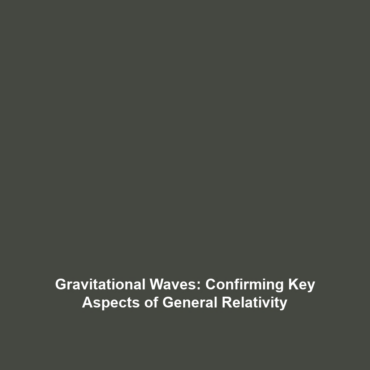How Gravitational Waves Confirm a Key Aspect of General Relativity
Gravitational waves, the ripples in spacetime produced by accelerating massive objects, have become a focal point in astrophysics. Their discovery provided groundbreaking evidence supporting Einstein’s General Theory of Relativity, particularly concerning the nature of gravity and the warping of spacetime. Understanding how these waves confirm the principles of relativity is essential, as it not only deepens our comprehension of the universe but also opens pathways for future scientific explorations.
Key Concepts
To grasp how gravitational waves affirm General Relativity, it’s crucial to examine several key concepts:
1. General Relativity
Introduced by Albert Einstein in 1915, General Relativity posits that gravity is not a force but a curvature of spacetime caused by mass. This foundational theory predicts the existence of gravitational waves.
2. Gravitational Waves
Gravitational waves are generated when massive objects, such as black holes or neutron stars, accelerate and create ripples in the fabric of spacetime. These waves propagate at the speed of light and carry information about their origins and the nature of gravity.
3. Detection of Gravitational Waves
The direct detection of gravitational waves by LIGO (Laser Interferometer Gravitational-Wave Observatory) in 2015 confirmed a major prediction of General Relativity. This milestone opened new avenues for astrophysical exploration, validating longstanding theories about cosmic events.
Applications and Real-World Uses
The implications of how gravitational waves confirm General Relativity extend into various practical applications:
- Astrophysics Research: Gravitational waves allow scientists to observe celestial events that are invisible through traditional electromagnetic observations.
- Tests of General Relativity: Ongoing observations of gravitational waves continuously test and refine the predictions made by General Relativity.
- Understanding Cosmology: These waves provide insights into the formation and evolution of the universe, including the study of black holes and neutron stars.
Current Challenges
Despite the advancements, several challenges persist in studying and applying how gravitational waves confirm General Relativity:
- High Sensitivity Requirements: Instruments like LIGO require extreme sensitivity to detect the minuscule ripples caused by distant cosmic events.
- Environmental Interference: Earth-based detectors face challenges from vibrations and other environmental factors that can affect measurements.
- Data Analysis Complexity: The vast amounts of data generated require sophisticated algorithms and considerable computational power for accurate analysis.
Future Research and Innovations
Future innovations in the study of gravitational waves and their connection to General Relativity include:
- Next-Generation Detectors: Projects like the Einstein Telescope and LIGO’s upgrades aim to enhance sensitivity and broaden detection capabilities.
- Multi-Messenger Astronomy: Combining gravitational wave detection with electromagnetic signals will provide a more comprehensive understanding of astronomical phenomena.
- Quantum Technologies: Advances in quantum sensing can lead to more precise measurements of gravitational waves, further substantiating General Relativity.
Conclusion
The confirmation of gravitational waves as predicted by General Relativity marks a significant achievement in modern physics. It not only validates Einstein’s theory but also opens new doors for research and technological advancements in astrophysics. As scientists continue to explore this field, further discoveries are anticipated, illustrating the profound interconnectedness of gravity, spacetime, and the universe. To learn more about gravitational waves and their implications, visit our related articles section.
